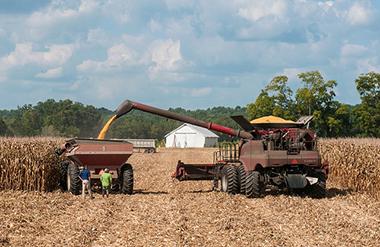The following story was originally published on the Food Security Portal’s Food for Thought blog.
Commodity prices regularly move together, despite the fact that causes of fluctuation can vary from commodity to commodity. Cross-market volatility could lower the effectiveness of diversification as a strategy for reducing price risks, so understanding the dynamics behind market interdependence and volatility transmission is critical. In a study recently published in Agricultural Economics, Cornelis Gardebroek, and IFPRI senior researchers Manuel Hernandez and Miguel Robles examine price volatility fluctuations in daily, weekly, and monthly log price returns across three major agricultural commodities in the U.S. over time to see if volatility in certain crops has spillover effects on others, and whether the degree of cross-market interdependence differs between the short term and the long term.
The authors chose corn, wheat, and soybeans for their analysis because they are the main crops produced (by planted acreage) and traded in the United States. Additionally, they are the most actively traded agricultural commodities in futures markets, and one of the objectives of the study is to weigh in on the debate as to whether stronger integration of agricultural financial markets have led to increased crop price interdependence. Using data from the futures database of the Commodity Research Bureau (CRB) and employing two multivariate GARCH models, the authors capture the direction, magnitude and persistence of volatility transmission across markets using different time frequencies.
While the authors do not find conditional correlation between the price returns in corn, wheat, and soybeans markets at the mean level, looking at the price fluctuations reveals volatility spillovers on a weekly or monthly basis, with shocks in wheat and corn markets showing particularly strong cross-market effects. More specifically:
- A shock in the corn market an impact of similar scale on soybeans volatility but a lower impact on wheat volatility, particularly at the monthly level.
- A shock in the wheat market has a significant effect on the volatility of corn and soybeans markets, and the transmission is much higher on a monthly than weekly basis.
- A shock in the soybeans market has comparatively low impact on either corn or wheat volatility.
The longer the time frame, the more direct effect on price fluctuation one observes. For example, price shocks and fluctuations in wheat returns appear to directly affect the current fluctuation in corn and soybeans returns at the monthly level, but less direct effects are observed a the weekly level and none at the daily level.
The lack of cross-market interdependence in the short term, which was a hypothesized effect of the increased integration of agricultural financial markets and accompanying “herding” and speculative behavior, leads the authors to recommend that policy makers should shift focus from tightening regulation of agricultural futures markets to the fundamental factors behind interdependence of agricultural commodity markets; these include input costs, access to natural resources and information, demand substitution, and other joint underlying causes of volatility. This study also supports the use of multiple data frequencies in future research to get the most robust picture of commodity price volatility.
Full article in Agricultural Economics: “Market Interdependence and volatility transmission among major crops”







